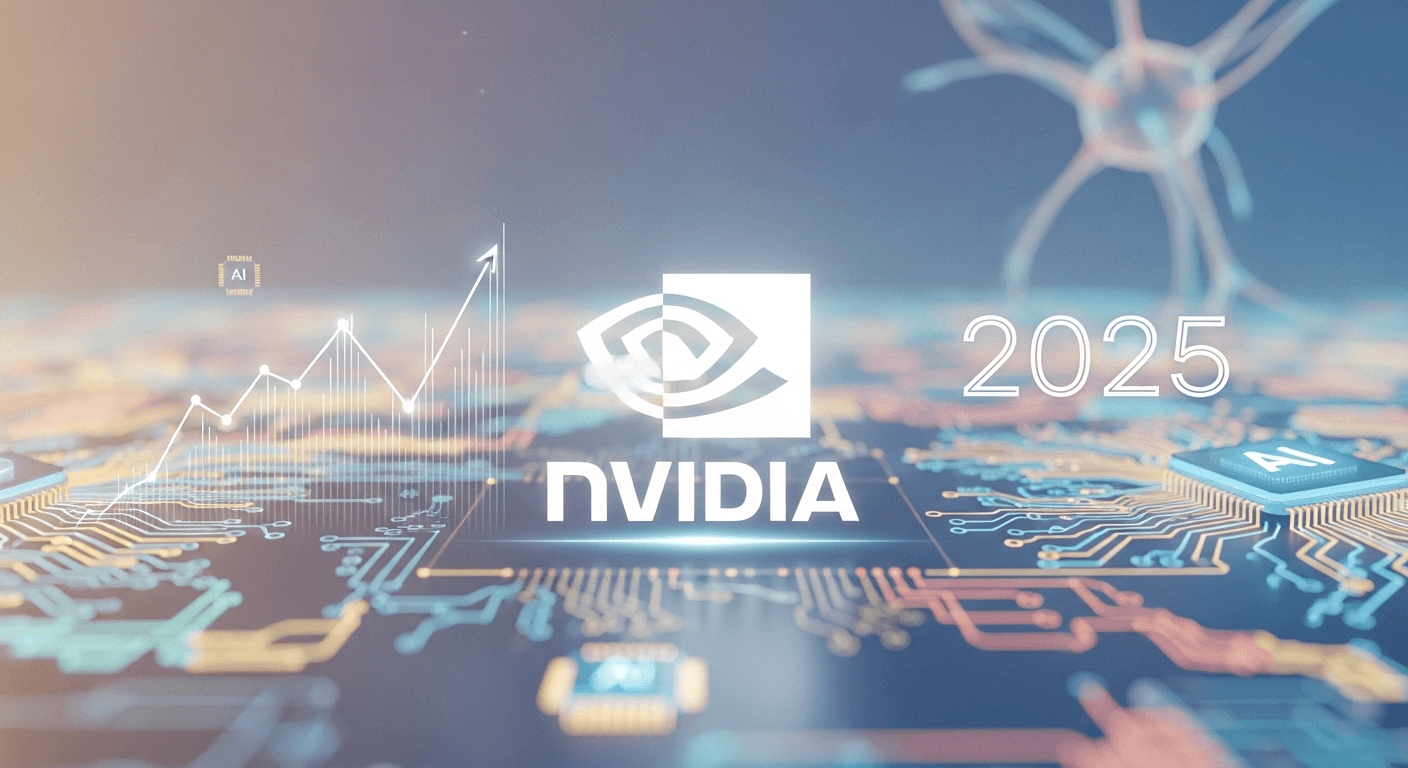Nvidia in 2025: Why the AI Chip Leader Remains One of the Best Stocks to Buy Now

Introduction
Artificial intelligence has transitioned from a mere buzzword to a significant budget line item for companies of all sizes. From Big Tech to startups and Fortune 500 firms, there’s an aggressive push to develop and deploy AI, with billions being invested in the necessary infrastructure. One company that remains pivotal in this space is Nvidia.
In this article, we’ll explore why Nvidia continues to be a top AI stock, how it capitalizes on the AI boom, the risks involved, and strategies for investing in this powerhouse.
Key Takeaways
- Nvidia provides the “picks and shovels” of AI. The company’s GPUs, networking solutions, and software support all AI applications, ensuring it benefits regardless of which models prevail.
- Outstanding results: Nvidia reported $46.7 billion in Q2 FY2026 revenue, with $41.1 billion generated from its data center segment alone. Notably, Blackwell data center revenue increased by 17% sequentially.
- Massive demand: Analysts estimate over $2 trillion in AI infrastructure spending this cycle, predominantly in compute and networking—Nvidia’s stronghold.
- A durable ecosystem: Nvidia’s CUDA-X stack and its vibrant developer community (over 6 million members) optimize software and workloads for its hardware.
- Valuation perspective: While Nvidia’s P/E ratio is in the high 30s, it remains reasonable compared to its growth potential.
Why “Picks and Shovels” Matter in AI
Every AI application, from chatbots to intelligent systems, relies on substantial computing power. Nvidia supplies this computing power in three main layers:
- Hardware: Data center GPUs (Hopper, Blackwell), rack-scale systems (NVL72), and high-speed networking solutions like NVLink and InfiniBand/Ethernet.
- Software: CUDA-X libraries, SDKs such as TensorRT and cuDNN, and the NIM microservices within NVIDIA AI Enterprise, enhancing model performance and cost-efficiency on Nvidia hardware.
- Platform: Comprehensive AI factory solutions and cloud-based DGX offerings combine hardware, networking, and software into a turnkey package.
This “full stack” model allows customers to prioritize performance over individual components, making it increasingly challenging to switch providers as they standardize on Nvidia.
Proof in the Numbers
The latest quarter (Q2 FY2026, reported August 27, 2025) reveals that demand for Nvidia products remains high:
- Total Revenue: $46.7 billion, a year-over-year increase of 56%.
- Data Center Revenue: $41.1 billion, also up by 56% year over year.
- Blackwell Data Center Growth: Revenue increased by 17% sequentially as shipments ramped up.
Interestingly, Nvidia reported zero H20 sales to China in this quarter due to export licensing constraints, yet growth continues to show how widespread the global demand truly is.
The Moat: CUDA and the Developer Network
Nvidia’s competitive edge lies not just in its chips, but also in the extensive software and developer ecosystem that accompanies them. With over 6 million developers using its CUDA-X libraries and thousands of CUDA-accelerated applications, the practical benefits—such as faster time-to-value and reduced operational risk—compound over time for enterprises.
The Roadmap: Raising the Bar
- Blackwell NVL72: A rack-scale system integrating 72 Blackwell GPUs and 36 Grace CPUs through fifth-generation NVLink and liquid cooling, designed for efficient training and quick inference, boasting up to 30 times faster real-time LLM inference than previous platforms.
- Blackwell Ultra (GB300 NVL72): The forthcoming model, projected to deliver approximately 1.5 times more AI performance compared to its predecessor, specifically targeting AI reasoning and agentic workloads.
This steady flow of innovations is crucial. In AI infrastructure, customers invest in long-term roadmaps, and Nvidia’s capacity to provide a clear upgrade path encourages firms to continue relying on its platform.
The Demand Picture: Ongoing Expansion
Early doubts regarding the scale of the AI buildout have evolved into more ambitious projections. Following CEO Jensen Huang’s trillion-dollar outlook, many analysts are now estimating over $2 trillion in AI infrastructure spending throughout this decade, predominantly focused on compute and networking, Nvidia’s core competencies.
Evidence of this spending is manifesting in the market. GPU cloud provider CoreWeave has repeatedly expanded its long-term capacity agreements with OpenAI, with deal values now exceeding $22 billion, showcasing how aggressively AI leaders are securing computational resources.
Is the Stock Still Reasonable?
Nvidia’s stock has seen substantial growth for valid reasons. Even after significant appreciation, its forward P/E ratio remains in the high 30s, a reflection that appears justified when considering the company’s impressive growth rates, margins, and cash generation.
The long-term performance has been remarkable, providing around a 1,300% total return over the past five years leading to late September 2025. While past performance is not a guarantee, it illustrates the potential that can emerge when various growth drivers align.
Who Are the Challengers?
Nvidia’s leadership is significant, but the company is not without competitors. Assessing the competitive landscape can help set realistic expectations:
- Hyperscaler Custom Silicon: Meta is developing its own MTIA chips and is acquiring startup Rivos to accelerate these initiatives, aiming to lessen its reliance on vendors like Nvidia for certain applications.
- AMD: The roadmap for the Instinct MI350/MI400, along with the upcoming “Helios” rack-scale platform, aims to compete in training and distributed inference, utilizing open standards and expanded HBM footprints.
- Google Cloud TPUs: With advances in v5p and sixth-generation Trillium, Google is enhancing performance and efficiency. Although TPUs primarily serve as a managed service, they compete for AI training and inference in the cloud.
The takeaway is that while competition is intensifying, it’s likely to grow the overall market rather than quickly displace Nvidia. Many of these alternatives are also integrated alongside Nvidia products in data centers.
Risks to Watch
- Geopolitical Issues and Export Restrictions: Policy changes could impact product availability, especially concerning China. Although Nvidia demonstrated growth without H20 sales to China in Q2 FY2026, this remains a crucial factor to monitor.
- Supply Chains and Packaging Capacity: Industry-wide constraints in advanced packaging (like HBM and CoWoS) could affect shipments.
- Customer Concentration and In-House Chips: Major clients may explore custom ASICs to reduce costs and power usage for specific applications, potentially affecting future orders.
- Valuation and Market Expectations: Much of Nvidia’s success is already factored into its stock price. If AI spending stagnates or shifts more rapidly towards custom silicon, the company’s valuation multiples might compress.
How to Invest in Nvidia Now
If you’re convinced of Nvidia’s long-term potential but cautious about volatility, consider a disciplined investment approach:
- Dollar-Cost Averaging: Spread your purchases over time to mitigate the stress of market timing.
- Diversify within AI Investments: Build a portfolio that includes complementary suppliers—such as networking, memory/HBM, or manufacturing firms—around Nvidia to reduce risk.
- Long-Term Perspective: The AI expansion is a multi-year journey. Anticipate fluctuations from quarter to quarter and size your investments appropriately to weather them.
Why Nvidia Remains One of the Best AI Stocks to Buy Now
- Category Leadership: Nvidia offers a unique and comprehensive stack of hardware, software, and systems.
- Robust Demand: Demand is tied to AI factory growth that appears larger than previously anticipated.
- Strong Developer Ecosystem: A large community enhances value and increases switching costs for customers.
- Consistent Product Innovation: A reliable cadence of innovation keeps clients committed to Nvidia’s roadmap.
- Impressive Financial Performance: Nvidia has consistently delivered outstanding results at scale.
What About Market Share?
Determining precise market shares can be challenging since the AI accelerator market spans GPUs, TPUs, and specialized ASICs. However, estimates still suggest that Nvidia leads significantly in data center AI computing, even as competitors gain traction. This dominance, combined with advantages from CUDA-X and networking, explains Nvidia’s sustained pricing power and strong profit margins.
Conclusion
If you’re seeking direct exposure to the AI infrastructure boom, Nvidia remains one of the most straightforward investment options available. The synergy between its numbers, roadmap, and ecosystem continues to strengthen. While competition and market volatility are expected, Nvidia holds a prominent position for long-term investors looking to capitalize on AI growth.
FAQs
What exactly does Nvidia sell in the AI sector?
Nvidia provides three main offerings: high-performance GPUs for training and inference, high-speed networking for connectivity, and an extensive software stack (including CUDA-X and various SDKs) that maximizes performance and developer productivity, forming a complete AI factory platform.
Isn’t Nvidia’s valuation too high?
While it’s not cheap, context is vital. With a forward P/E ratio in recent estimates around the high 30s—along with strong growth rates, margins, and cash flow—Nvidia’s valuation appears more balanced than it may seem at first glance.
Could competitors undermine Nvidia’s position?
While challengers can erode Nvidia’s market share for specific applications, the overall market is expanding rapidly. Nvidia’s ecosystem remains robust and resilient against competitors.
How significant is the AI infrastructure buildout?
The scale of the buildout is larger than many forecasts from just two years ago. Some analysts now predict over $2 trillion in AI infrastructure spending during this current cycle, with the majority directed toward compute and networking—Nvidia’s area of expertise.
How has Nvidia performed for long-term investors?
Nvidia has excelled, delivering around a 1,300% total return over the past five years through late September 2025. While past performance doesn’t guarantee future results, it reflects the company’s ability to execute consistently.
Disclosure
This article is for educational purposes only and is not investment advice. Be sure to conduct your own research, assess your financial situation and risk tolerance, or consult a licensed financial advisor before making investment decisions.
Thank You for Reading this Blog and See You Soon! 🙏 👋
Let's connect 🚀
Latest Blogs
Read My Latest Blogs about AI

California’s New AI Companion Chatbot Law: What SB 243 Changes and Why It Matters
California has enacted SB 243, the first U.S. law for AI companion chatbots. Discover the changes, when it takes effect, and how builders can comply.
Read more


